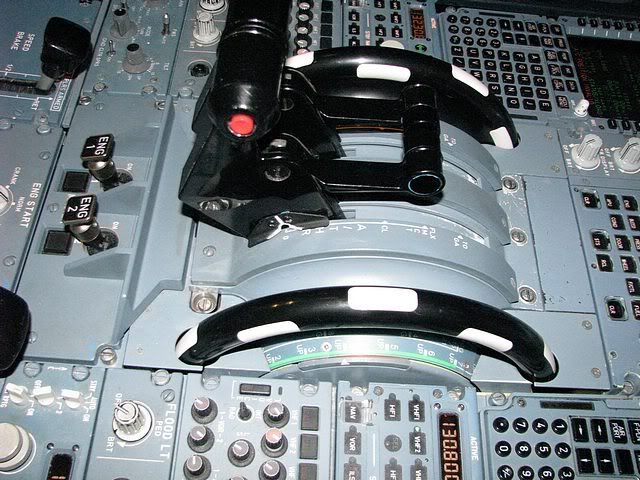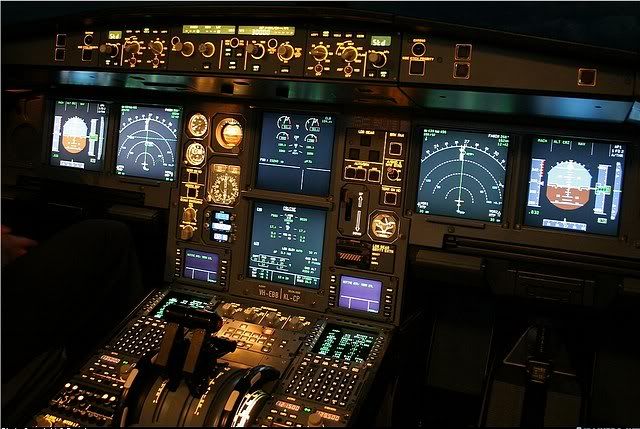Machinbird;
The following are images of the two ECAM pages which are always default-visible during the Cruise phase of the flight.
System pages may be viewed at any time on the bottom ECAM display by selecting that system from a panel on the pedestal, just below the ECAM displays. Should an abnormality occur, the affected system page is displayed automatically.
A
very brief description:
The E/WD appears on the upper ECAM display unit (DU).
The upper part of this DU displays :
Engine parameters (refer to 2.71.90)
Fuel on board (FOB) (refer to 2.28.20)
Position of slats and flaps (refer to 2.27.40)
The lower part of this DU displays messages generated by the FWC :
Warning and caution messages when a failure occurs
Memos when there is no failure
The lower part, which is dedicated to ECAM messages, is divided into two parts of several lines each.
Left part :
Primary or independent warnings and cautions, or
Memo information
Right part :
Title of system affected by a primary or independent warning or caution in case of overflow on the left part, or
Secondary failure, or
Memo, or
Special lines (such as AP OFF, LAND ASAP)
As soon as the FWC detects a failure, and if there is no flight phase inhibition active, the E/WD displays the title of the failure and actions to be taken.
The action line clears automatically when the flight crew has executed the required action.
A picture is worth a thousand posts. Top ECAM E/WD, Engine and Warning Display:

The Lower ECAM, SD - Status Display.

The THS setting is not displayed but the GWCG (Gross Weight CofG) is. The THS setting is available on the F/CTL - Flight Control ECAM page; note that the bottom section of the display remains the same:

Below is a clearly-visible mechanical indication of the actual THS position right beside the mechanical THS trim wheels on the pedestal. the small pointer below the scale is the position of the THS. Along with the indication on the ECAM and in the MCDU, (Multi-Purpose Control and Display Unit -the interface keyboard with the FMGEC), it is checked for correctness on takeoff after the T/O data is received and the THS manually set (using the trim wheel).
Trim is otherwise automatic in flight.
The photo is taken from the F/O's seat.

Below is a very good image of an A330 cockpit at night. Notice the center ECAM screens in the standard cruise configuration; the THS actual position is visible in the green band beside the THS wheels on the thrust lever quadrant.

Originally Posted by Machinbird
I also suspect that the A-330 can be held in a deep stall by full nose up trim and an aft CG and yet be stabilized in a relatively stable normal flight attitude by the flight control system.
If I may offer a thought on this, what you're describing is a masking effect of an autoflight system; in such a scenario, the aircraft is assumed to be seriously out of trim but the autoflight system is masking the circumstances causing the mis-trimming by deflecting the flight controls or trimming to extreme positions. Across-wing fuel imbalances are thought to be one example.
The trim tank on the A330 holds about 4200kg of fuel, taking the CofG further aft to off-load the horizontal stabilizer from the traditional work it must do to during flight. The CofG is usually run between 29 and 37% MAC with a max after CofG, if I recall from a previous post, of around 39%.
That the THS began to trim NU to the point of "deep stall" (once the autopilot disconnected?) as a result of erroneous data signaling lower airspeed (requiring more NU trim) was not observed/noted in the other thirteen pitot/airspeed events which are listed at the end of the BEA Interim Report 2. I don't believe that the THS would be trimmed NU, while on autopilot, to the point where a deep stall condition would be latent with a resulting LOC once the autopilot disengaged. Just a thought....I may be misunderstanding your thought however!
We don't know anything about the THS setting for AF447 and so anything is conceivable. Whether it is probable, meaning that the possibility is within the design scope of the airplane, is, up to a point, a discussable matter. In the end, I believe that software engineers of extremely sophisticated systems such as exist in aircraft, will tell us that all possible modes of response can be known or tested nor can software be validated for all existing possibilities (whether they have occurred or not). I believe the QF A330 experience was like this; the BEA Report 2 does observe however that the QF event bears no similarity to AF447.
Hope this helps, Machinbird. It is far more difficult to explain the airplane in a typed discussion than by either flying it or even talking about it.
PJ2